
Download the PDF of this article
Think of how you feel when you have pushed yourself to take a risk and achieved something. It’s exhilarating and brings a sense of pride, often accompanied with the motivation to try and do more. The urge to physically challenge ourselves and take risks is inbuilt, with even very young children doing this as they pull themselves up against furniture or take their first steps.
Risky play is defined by Ellen Sandseter, professor at Queen Maud University’s College of Early Childhood Education in Trondheim, Norway, as thrilling and challenging forms of play that involve a risk of injury. She describes how children engage in this type of play in six categories:
- Play at great heights
- Play with high speed
- Play with dangerous tools
- Play near dangerous elements
- Rough-and-tumble play
- Play where children can disappear/get lost.
So physical activities such as balancing, hanging upside down, climbing, rolling, spinning around, whizzing along and jumping from heights can all be considered risky play and are essential for developing gross and fine motor skills, co-ordination, core strength and overall body awareness. Then there is the addition of risk through exploring hidden places and building dens, using real tools and even introducing children to dangerous elements such as fire.
Engaging in adventure, taking risks and facing challenges enables children to experience new learning opportunities and understand what they are able to do, as well as the limits of their physical capabilities. Importantly, these activities are fun and allow children to be physically free and active.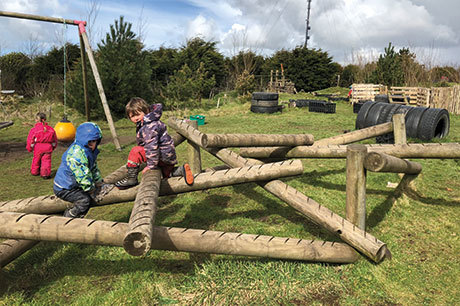
HAVE A GO
Rather than urging children to be careful and attempting to remove all risks, some early years practitioners are embracing the benefits of allowing children to engage in risky play and actively incorporating risk and challenge into their settings (see Case study).
Even the Health and Safety Executive has published a document clarifying the benefits of allowing children to have challenging play opportunities (www.hse.gov.uk/entertainment/childs-play-statement.htm). It states, ‘Play is great for children’s well-being and development. When planning and providing play opportunities, the goal is not to eliminate risk, but to weigh up the risks and benefits. No child will learn about risk if they are wrapped in cotton wool.’
Kathryn Solly, specialist early years trainer, speaker and author, agrees, ‘The real way to keep children safe is to allow them to have experiences and challenges and push themselves beyond their capabilities by exploration, which they can then apply to their life in general. Children aren’t stupid. They quickly learn skills. For example, a glue gun is hot and they may touch it once but they won’t a second time. Children benefit from the physicality of taking risks and their mental and physical health will benefit from more freedom.’
Julie Mountain, director of Play Learning Life, urges practitioners to think what harm they are potentially causing by not allowing children to take risks. It can inhibit their development and they are more likely to be clumsy, have poor balance, little control of their motor skills and, overall, be less physically fit.
Removing risk can also lead to children being timid and reluctant to attempt new things both physically and academically.
Before introducing new resources to encourage risky play, she asks practitioners to examine their own practice, question why they have been stopping children from doing activities deemed risky and read about risk-benefit assessments. ‘It’s crucial that an environment is made as safe as necessary, not as safe as possible,’ she emphasises.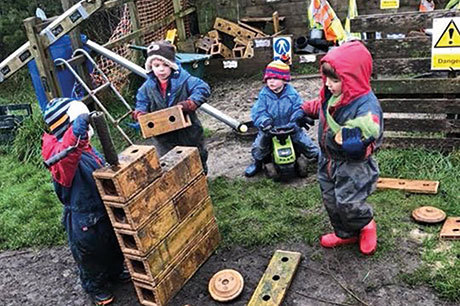
case study: Little Explorers Outdoor Pre-school in Redruth, Cornwall (part of Highway Farm Activity Centre)
‘Through adventurous play we’re trying to set up life skills so that children can be physically active, negotiate risk and manage their own risks as well as develop academic skills,’ says owner and head of early years Martin Besford.
‘Our children are outside the majority of the time and are learning how to negotiate moving on different terrain, including uneven grass, slopes and mud, rather than just flat safety surfaces, so they are building their body tone. Using their bodies in different ways – such as pulling themselves up hills on ropes, jumping from logs and swinging off trees – enables them to build gross motor skills, which are needed before children can do activities such as write.
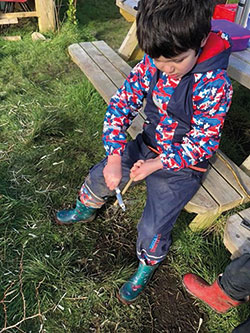 ‘Children use tools and are shown how to do things such as whittle sticks to a point, using potato peelers before moving on to knives when they become more confident and competent. They can then make ink by crushing charcoal from the campfire or blackberries in a pestle and mortar. The children excavated the digging pit so much that we made it into a wildlife pond. They recently worked out for themselves how to use hand drills to make holes in metal signs in order to screw them to wooden posts and put them in the area.
‘Children use tools and are shown how to do things such as whittle sticks to a point, using potato peelers before moving on to knives when they become more confident and competent. They can then make ink by crushing charcoal from the campfire or blackberries in a pestle and mortar. The children excavated the digging pit so much that we made it into a wildlife pond. They recently worked out for themselves how to use hand drills to make holes in metal signs in order to screw them to wooden posts and put them in the area.
‘We have set risk assessments but also follow dynamic risk assessments so that we can allow for the natural progression of an activity if the practitioner believes it’s safe. For example, children deciding to put a cargo net over the bird nest climbing frame. We risk-assess trees and check the branches are sturdy enough to take a child’s weight, and set the height children are allowed to climb by tying a ribbon to the branches until we feel they’re competent to climb higher. We zone areas and limit where children have free flow at the start of the year until we’re happy that they are confident to go from the areas with tyres to climb, balance beams, slides and swings to other spaces with higher-risk elements. ‘I advise practitioners to start small and slowly, introducing more risk, such as low balance beams or stepping stones, or adding to existing play structures by attaching hanging knotted ropes or nets.
‘We regularly have campfires, but you can start with tin can cooking, or having a story beside a fire, before encouraging children to sort kindling, help light the fire and cook on it.
‘Children hugely benefit physically from this adventurous play, as does their confidence and critical thinking. When our children start school they’re well-rounded and happy to give things a go.’
RECOMMENDED EQUIPMENT
LOOSE PARTS
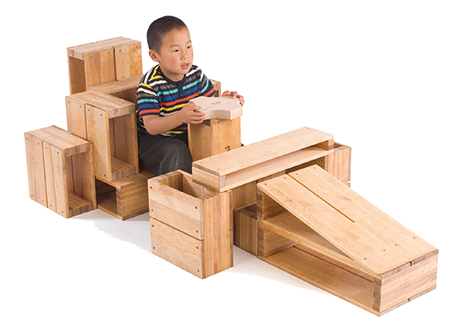
‘The more opened-ended an item is, the more useful it is for risky play,’ says Kathryn Solly. ‘Like all equipment, purpose built or collected, loose parts need to be checked and audited.’
Consider providing wooden blocks (Community Playthings’ Hollow Blocks, sets from £195, pictured), crates (Early Years Resources, pack of 4 crates, £39.95), planks (Early Excellence, set of wooden planks, £65), rope, tubes, pipes and tyres. Lifting, transporting and positioning these resources will promote challenging and imaginative play as children develop their gross and fine motor skills and hand-eye co-ordination. Children’s physical development is also promoted by playing with the resources, such as balancing along the planks, jumping off crates and rolling in tubes.
HEIGHTS AND CLIMBING
Climbing– whether on a purpose-built climbing frame, up trees or another structure – can give children an exciting feeling of achievement as they look around and gain a new perspective of their environment. Climbing allows children to improve their co-ordination, flexibility, and upper-body, grip and arm strength. Spatial and directional awareness, as well as balance, agility and problem-solving, are all involved.
Think about the opportunities you can provide for all the children in your care – simply mastering climbing stairs or onto a sofa can be a big achievement for toddlers. Utilise what you’ve already got, such as uneven surfaces and steps for crawling up and down, sturdy trees with low branches or simply a step ladder in the block area.
If investing in a climbing frame, Julie Mountain says they don’t have to be big. She recommends ones that offer challenge and are open-ended so they can be turned into a den or have a slide, net or swing attached.
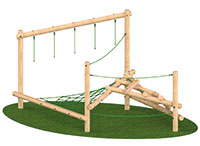 Clamber stacks, a mixture of rope and wood, are a good option for offering challenge to a range of ages and abilities (Clamber Stacks from A E Evans, starting from £625 up to £8,000 depending on timber, dimensions and equipment, pictured bottom centre), or a ‘birds nest’ climbing frame (Birds Nest Climbing Frame from Hand Made Places, £1,595).
Clamber stacks, a mixture of rope and wood, are a good option for offering challenge to a range of ages and abilities (Clamber Stacks from A E Evans, starting from £625 up to £8,000 depending on timber, dimensions and equipment, pictured bottom centre), or a ‘birds nest’ climbing frame (Birds Nest Climbing Frame from Hand Made Places, £1,595).
PLAYING AT SPEED
There’s a great thrill gained from almost but not quite losing control. Ride-on toys (Kiddie Carfrom Community Playthings, £106, pictured), scooters (Twin Wheeled Chunky Scooter from TTS, £57.95) and bicycles (Classic Balance Bike from Strider, £66) are an obvious way to provide this sensation for children, but are best used in a large defined area – perhaps marked with bushes or logs. Through riding a bike, children develop balance and core 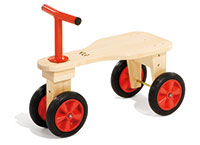 stability along with visual and bilateral co-ordination skills.
stability along with visual and bilateral co-ordination skills.
The feeling of speed can also be gained simply by running, rolling down a hill, or whizzing down a slide. Ms Mountain suggests utilising a natural slope or man-made mound and providing an embankment slide (Wicksteed prices start at £2,456; or Playdale stainless steel slide from £2,509), or swinging from a rope, purpose-built swing or hammock (Mini Netted Hammock from Muddy Faces, £9.99). Through propelling themselves on swings, children are developing co-ordinated movements, while sliding contributes to children’s vestibular stimulations, which helps develop a sense of balance and sense of their own body in space.
DANGEROUS TOOLS
‘Children should have access to real tools, rather than plastic imitations,’ says Ms Solly. They need to be shown how to use the tools purposefully and safely and it’s important to have supervision, policies and procedures in place. Encourage children to make their own risk assessments, such as, ‘What would happen if I hold the saw like this?’ Through handling and using tools, children are able to develop their arm and hand muscles and co-ordination of their bodies, along with the pleasure of being creative and inventive.
Woodwork is great for encouraging the use of tools (see our article on page 7), but real tools can also be introduced to children through activities such as cooking, sewing or the inclusion of glue guns in the creative area, or child-sized gardening tools outdoors (Budding Gardener tools from Harrod Horticultural, starting from £7.95).
DANGEROUS ELEMENTS
It is not unusual to see children cooking with or being close to fire in Scandinavian childcare settings (Safe Ring Fire Pit from Cosy, £289, or Fire Bowl from Muddy Faces, £49.99).
‘If children don’t get the opportunity to get close to fire and experience the heat and see what happens to a sugary marshmallow, then the possibility is that they won’t understand fire and are more likely to get injured when they come across it,’ says Ms Mountain.
Being around potentially dangerous elements such as fire and water can help children develop physical self-control.
DISAPPEARING
By engaging in exploration and adventure hidden from the adult’s gaze, children are able to test their physical capabilities and experience the thrill of being alone or with their peers. Use natural outdoor features, such as bushes and mounds, or plant a willow den, to enable children to hide and explore.
Also provide den-making equipment, both outside and indoors, which promotes the physical act of building – lifting, hoisting, balancing, fastening – as well as the reward of having a private place to retreat to (Den Kit from Muddy Faces, £16.49, or Den Making Kit from Early Years Resources, £119.95). A cost-effective solution is to buy selected separate elements and ask parents to donate resources such as pegs, poles and old sheets.









